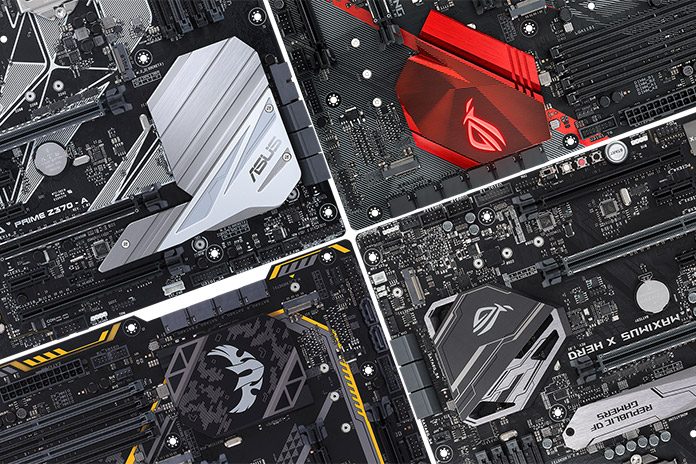ROG brews a fully caffeinated family
The Republic of Gamers represents the pinnacle of engineering and design for ASUS motherboards. For more than a decade, this internal division has been pushing the envelope to satisfy hardcore enthusiasts and gamers who demand the best. ROG is both a breeding ground for new features and a proving ground where we test the absolute limits of performance.
Now in its 10th iteration, the Maximus series brings ROG’s expertise to bear on Z370 and Coffee Lake. The family includes the armored Maximus X Formula and Code, the LN2-ready Maximus X Apex, well-rounded Maximus X Hero.
Live life aquatic on the Maximus X Formula
Ten years ago, the original Maximus Formula became the first motherboard to combine air and liquid cooling. Its spirit lives on in the new Maximus X Formula, which is brimming with cutting-edge features fit for showcase PCs.
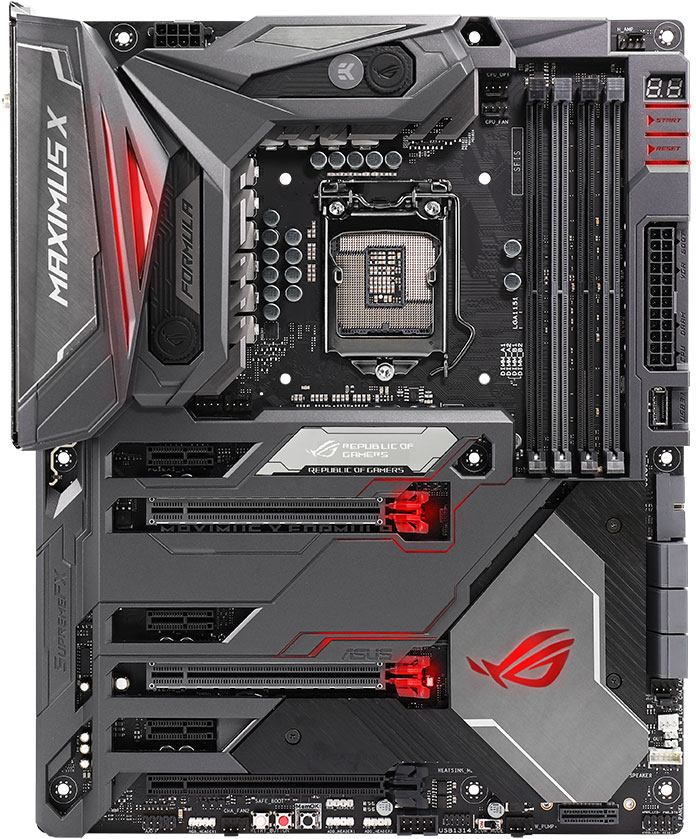
In this latest generation, hybrid cooling is provided by a CrossChill EK II VRM block developed by the experts at EK Water Blocks. The bespoke design has enough surface area to keep the power circuitry cool with typical airflow, but it performs best with liquid coursing through its central copper channel. Adding the block to a system-wide loop is easy thanks support for standard fittings, and while you’re at it, you can tap into the pump, temperature, and flow sensors integrated into the board.
ROG armor protects the surface and provides a streamlined canvas for your masterpiece. This external skin is laser-etched to let threads of Aura Sync lighting shine through, and additional RGB LEDs are embedded in the I/O shroud, chipset heatsink, and power and reset buttons. They’re joined by dual headers for standard RGB strips, plus two more for addressable gear, giving the Formula the most extensive lighting in our Z370 lineup.
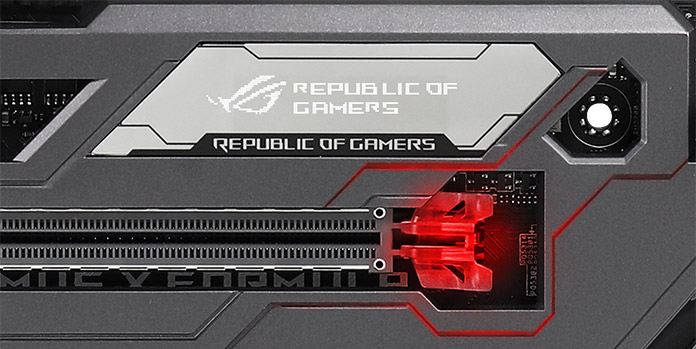
In a new twist for the Maximus family, we’ve mounted a 1.3” LiveDash OLED to the center of the board. The monochrome display can show small static images and animated GIFs, adding another layer of customization for creative builders. Vital system stats like clocks and temperatures can also be displayed in real time, which balances the cosmetic appeal with functional benefits.
Form and function also meet around the back, where a carefully shaped metal plate livens up what would otherwise be a boring view. More importantly, the backplate bolsters the PCB to prevent warping under the weight of heavy hardware, and it dissipates heat from under the VRMs to aid cooling. Then there’s the integrated shield for the rear I/O ports, which completes the Formula’s slick exterior while addressing a common pain point for motherboard installation.
| ROG Maximus X Formula | |
|---|---|
| Size | ATX |
| Memory | 4 x DDR4 up to 4133+ (OC) |
| Multi-GPU | 2 x SLI, 3 x CrossFireX |
| PCIe | 2 x16 (CPU): x16, x8/x8 1 x16 (Chipset): x4 3 x1 (Chipset) |
| Storage | 1 x M.2 (NVMe x4 or SATA 6Gbps) 1 x M.2 (NVMe x4) 6 x SATA 6Gbps |
| Networking | Intel I219-V Gigabit Ethernet 2x2 802.11ac WiFi MU-MIMO |
| Audio | SupremeFX S1220 codec ESS Sabre ES9023P DAC |
| USB | 3.1 Gen 2: 1 x front, 1 x Type-C, 1 x Type-A 3.1 Gen 1: 2 x front, 4 x Type-A 2.0: 2 x front, 4 x Type-A |
| Aura | IO shield, PCIe slots, chipset heatsink, power/reset buttons, 2 x strip headers, 2 x addressable headers |
| Cooling | 2 x pump headers (AIO, pump+) 5 x fan headers 1 x high-amperage fan header 3 x thermal sensor headers (2 x liquid) 1 x flow header |
| Price | $449.99 USD $593.99 CAD |
| Availability (USA) | Micro Center Amazon B&H |
| Availability (Canada) | Canada Computers |
That’s just the extras; the Maximus X Formula also boasts a full complement of more conventional features, including a trio of PCIe x16 slots, room for dual M.2 SSDs, integrated 802.11ac WiFi, an ESS Sabre DAC, and three kinds of USB 3.1 Gen2 connectivity. If you want one Z370 motherboard to do it all, the Formula is tough to beat.
The Maximus X Code streamlines your Coffee Lake build
Based on the same underlying motherboard as the Formula, the Maximus X Code scales back the exotic extras to focus on enthusiast essentials for less extravagant builds. The CrossChill EK II block and full backplate are swapped for substantial heatsinks up front and smaller metal strips around back, but there’s still plenty of VRM cooling to take Coffee Lake well beyond stock speeds.
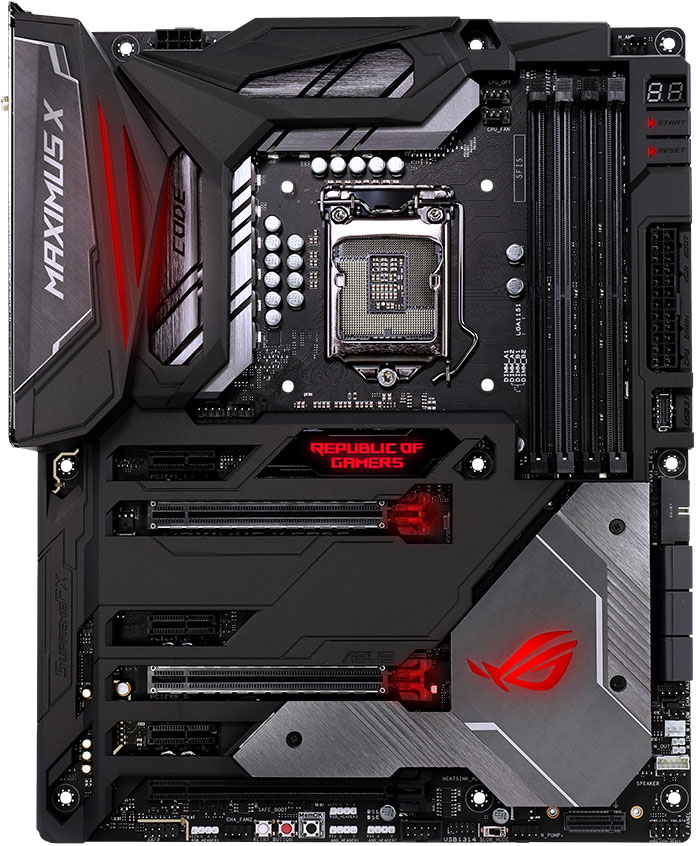
Although the full coat of armor remains, it’s blacked out for a stealthier look, and the LiveDash display is replaced by an illuminated ROG badge. The onboard lighting is slightly more subdued overall but still open to extensive expansion. Like on the Formula, you get four Aura Sync headers: two for standard RGB strips and two more for addressable devices.
Otherwise, the Code is basically the same as its liquid-fueled sibling. The M.2 layout is identical, putting one slot under a substantial heatsink that dissipates heat, and another poking out vertically where SSDs can benefit from ambient airflow. Dual SafeSlots are spaced for larger cards like the ROG Strix GTX 1080 Ti, and a third x16 offers four lanes through the chipset.
Upgraded audio removes the need for a separate sound card. As with the Formula, the Code combines a SupremeFX S1220A codec with an ESS Sabre DAC that produces better sound. Both boards come with the latest versions of our Sonic Radar and Sonic Studio software, and the latter can improve VR immersion by injecting HRTF-powered surround effects into native audio streams for Oculus Rift and HTC Vive headsets.
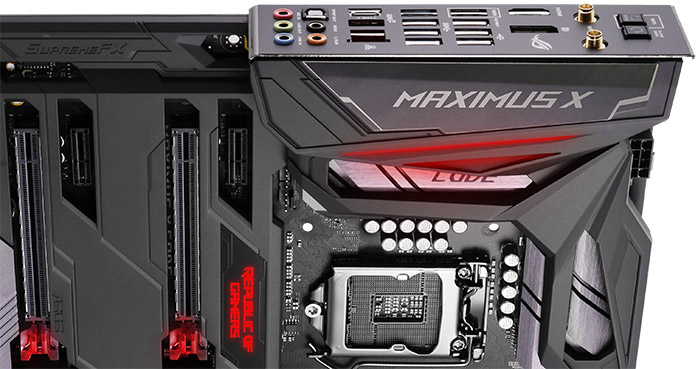
Connectivity is plentiful enough for fully loaded rigs. In addition to sporting loads of USB ports, including multiple flavors of the latest USB 3.1 Gen2 spec, the Code boasts Intel Gigabit Ethernet and 802.11ac WiFi. The rear ports are surrounded by the same integrated I/O shield that appears on the Formula, complete with convenient buttons for clearing the CMOS and activating USB BIOS Flashback.
| ROG Maximus X Code | |
|---|---|
| Size | ATX |
| Memory | 4 x DDR4 up to 4133+ (OC) |
| Multi-GPU | 2 x SLI, 3 x CrossFireX |
| PCIe | 2 x16 (CPU): x16, x8/x8 1 x16 (Chipset): x4 3 x1 (Chipset) |
| Storage | 1 x M.2 (NVMe x4 or SATA 6Gbps) 1 x M.2 (NVMe x4) 6 x SATA 6Gbps |
| Networking | Intel I219-V Gigabit Ethernet 2x2 802.11ac WiFi MU-MIMO |
| Audio | SupremeFX S1220 codec ESS Sabre ES9023P DAC |
| USB | 3.1 Gen 2: 1 x front, 1 x Type-C, 1 x Type-A 3.1 Gen 1: 2 x front, 4 x Type-A 2.0: 2 x front, 4 x Type-A |
| Aura | IO shield, PCIe slots, chipset heatsink, ROG badge, power/reset buttons, 2 x strip headers, 2 x addressable headers |
| Cooling | 2 x pump headers (AIO, pump+) 5 x fan headers 1 x high-amperage fan header 3 x thermal sensor headers (2 x liquid) 1 x flow header |
| Price | $319.99 USD $422.99 CAD |
| Availability (USA) | Amazon B&H |
| Availability (Canada) | December |
A tighter overall focus makes the Maximus X Code an appealing alternative to the Formula even if you’re contemplating custom liquid cooling. After all, you still get a full suite of liquid cooling headers, and only the most sophisticated loops include VRMs.
Pour out some LN2 for the Maximus X Apex
Lots of motherboard makers claim the best performance, but we’ve got the results to prove it. Much of the credit goes to the Apex, an overclocking savant purpose-built for taking new CPUs to the ragged edge at sub-zero temperatures. Apex boards were introduced earlier this year with the Maximus IX series, and they’ve already claimed multiple world records and top scores with Intel’s Z270 and X299 platforms. Now, our internal overclocking team has continued that streak with the new Maximus X Apex, setting a new record frequency with Coffee Lake at 7.3GHz, along with top scores in 10 benchmarks.
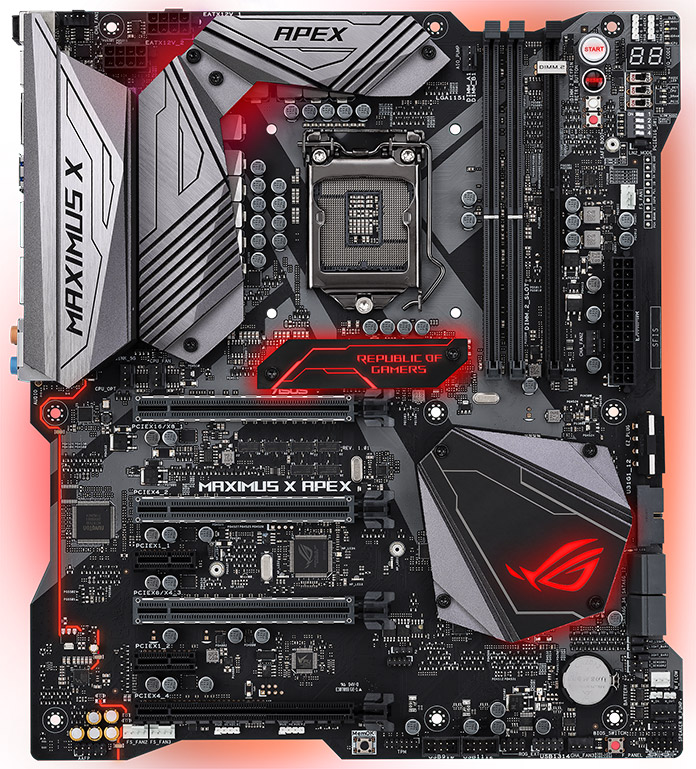
Our obsession with performance is evident throughout the board’s design, from the dual 8-pin connectors that supply extra power to the CPU, to the special operating modes required when liquid nitrogen is flowing. Fresh for this generation, we’ve created a special fan bracket for the I/O heatsink that lets hardcore overclockers blow LN2 vapor away from their CPU pots. The Apex adds full-speed fan headers specifically for this purpose, plus everything required for liquid cooling and traditional system fans.
Less is more on the memory front, where the Apex uses dual slots to hit higher DDR4 frequencies than four-slot boards. The traces are slightly more direct with only one slot per channel, allowing the best CPUs and memory to reach up to DDR4-4200 and beyond. The slot next to the memory is for our DIMM.2 module, which accepts dual M.2 SSDs and includes mounting points for fans. Four PCIe x16 slots stand ready for copious GPU horsepower, equipping the Maximus X Apex for peak performance in every category.
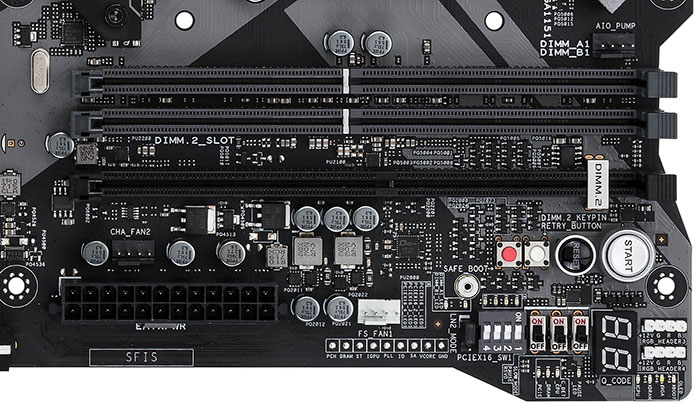
Even the networking is kicked up a notch. In addition to featuring the requisite Intel Gigabit Ethernet controller, the Apex has an Aquantia AQC-108 chip that can push throughput up to five times higher. This auxiliary controller supports Gigabit, 2.5G, and 5G connectivity, so it can step up to faster speeds as you upgrade your network.
Despite focusing on hardcore overclockers and performance junkies, the Apex line has gained a following among PC enthusiasts who are drawn to its distinctive X-shaped circuit boards. On the appropriately named Maximus X version, a ground-effect glow emanates from the PCB cut-outs to accentuate the shape, while onboard lighting provides tasteful accents on the surface. If you want to get creative, the backlit ROG nameplate can be replaced with one featuring custom-cut graphics. Add the four RGB strip headers, and there’s enough Aura Sync illumination to light up elaborate custom mods and even entire rooms.
| ROG Maximus X Apex | |
|---|---|
| Size | Extended ATX |
| Memory | 2 x DDR4 up to 4266+ (OC) |
| Multi-GPU | 2 x SLI, 4 x CrossFireX |
| PCIe | 3 x16 (CPU): x16, x8/x8, x8/x4/x4 1 x16 (Chipset): x4 2 x1 (Chipset) |
| Storage | 1 x M.2 (NVMe x4 or SATA 6Gbps) 1 x M.2 (NVMe x4) 4 x SATA 6Gbps |
| Networking | Aquantia AQC-108 5G Ethernet Intel I219-V Gigabit Ethernet |
| Audio | SupremeFX S1220A |
| USB | 3.1 Gen 2: 1 x Type-C, 1 x Type-A 3.1 Gen 1: 2 x front, 6 x Type-A 2.0: 6 x front |
| Aura | VRM heatsink, chipset heatsink, nameplate, PCB backlight, 4 x strip headers |
| Cooling | 2 x pump headers (AIO, pump+) 5 x fan headers 3 x full-speed fan headers 4 x thermal sensor headers (2 x liquid) 1 x flow header |
| Price | $349.99 USD $461.99 CAD |
| Availability (USA) | Amazon |
| Availability (Canada) | Memory Express |
By straddling the line between performance and style, the Maximus X Apex provides a unique opportunity to overclockers and builders who want to stand out. Look for it soon at $349.99 USD and $461.99 CAD.
Be a Maximus X Hero, just for one day
With premium features and powerful tuning options, the Maximus X Hero has everything serious gamers and enthusiasts need. The well-rounded spec hits all the right notes without excess you can do without.

Cooling options abound for liquid and air; in addition to headers for all-in-one coolers and stand-alone pumps, there are hookups for monitoring liquid temperatures and flow. Add support for up to five standard 3/4-pin fans, plus one high-amperage spinner, and there’s enough system cooling for all your high-end hardware. The Hero is also compatible with the ASUS Fan Extension Card, which adds headers for even more fans and temperature probes.
A passive heatsink provides SSD cooling for drives installed in the primary M.2 slot. The secondary slot is situated in the bottom corner, away from typical hot spots and right next to a mounting stud for 3D-printed accessories.
Aura Sync lighting gently illuminates the I/O shield along with the M.2 and chipset heatsinks. It also extends to the onboard headers for addressable and standard RGB devices. There are dual connectors for RGB strips, each capable of powering up to two meters of lighting at peak brightness, and one more for addressable RGB devices. The Hero’s metal-on-monochrome motif won’t clash with any of the rainbow of colors on tap, and it looks still fantastic in stealth mode, with the lighting turned off.

Instead of relying solely on a SupremeFX codec, the onboard audio further improves fidelity with an ESS Sabre DAC. This tag team offers greater range and an exceptional 120-dB SNR, so there’s no need for a discrete sound card. It’s complemented by our latest Sonic Studio III software, which uses HRTF-based virtual surround effects to plunge you deeper in VR experiences powered by headsets like the Oculus Rift and HTC Vive.
The Maximus X Hero has ample USB connectivity for VR and multiple USB 3.1 Gen2 flavors for next-gen peripherals. These ports pierce an I/O shield that’s fully integrated into the board for easier installation and a cleaner overall look. Along with the usual assortment of ports, the rear cluster boasts dedicated buttons for clearing the CMOS and activating USB BIOS Flashback, a handy low-level utility that can update the firmware with only a PSU and thumb drive attached.
| ROG Maximus X Hero | |
|---|---|
| Size | ATX |
| Memory | 4 x DDR4 up to 4133+ (OC) |
| Multi-GPU | 2 x SLI, 3 x CrossFireX |
| PCIe | 2 x16 (CPU): x16, x8/x8 1 x16 (Chipset): x4 3 x1 (Chipset) |
| Storage | 1 x M.2 (NVMe x4 or SATA 6Gbps) 1 x M.2 (NVMe x4) 6 x SATA 6Gbps |
| Networking | Intel I219-V Gigabit Ethernet 2x2 802.11ac WiFi MU-MIMO (optional) |
| Audio | SupremeFX S1220 codec ESS Sabre ES9023P DAC |
| USB | 3.1 Gen 2: 1 x front, 1 x Type-C, 1 x Type-A 3.1 Gen 1: 2 x front, 4 x Type-A 2.0: 4 x front, 2 x Type-A |
| Aura | IO shield, M.2 heatsink, chipset heatsink, 2 x strip headers, 1 x addressable header |
| Cooling | 2 x pump headers (AIO, pump+) 5 x fan headers 1 x high-amperage fan header 3 x thermal sensor headers (2 x liquid) 1 x flow header |
| Price | $259.99 USD $279.99 USD (WiFi) $369.99 CAD (WiFi) |
| Availability (USA) | Newegg* Amazon* Amazon |
| Availability (Canada) | Memory Express* |
Versions of the Maximus X Hero are available with or without a wireless module that offers dual-band 802.11ac WiFi and Bluetooth support, leaving you free to pick the right one for your networking needs. The standard model is selling for $259.99 USD, while its WiFi twin rings in at $279.99 USD and $369.99 CAD. Look for them at the retailers listed above.

